Thomson, Netgear and ZyXEL Head to Head!
I'd had the opportunity to have a brief "play" with a Thomson ST585 v6 (as, then, supplied by O2) and have to say I found the web interface less than intuitive.
When my own TG585 v7 arrived from Be*, I found it equally unfriendly. In particular, I had great difficulty attempting to change it's default LAN IP address (192.168.1.254) which otherwise meant re-configuring a roomful of PC's which all had fixed IP addresses.
I also found configuring port-forwarding in the TG585 v7 to be difficult, to say the least. Although defining new "Games and Applications" and assigning them port numbers was straightforward enough, I was unable to assign the new definitions their corresponding PCs unless they were 'plugged in' and connected to the network ("Connected Devices"). This meant that I was unable to configure the TG585 v7 off line in order to have it "rarin' to go" when the great moment arrived and my BT line went dead at switchover time.
With all this in mind, I was hoping that my Netgear DG834G v4 would cut the mustard and I could happily leave the BeBox in it's mailer. Thanks to replies from the always-helpful people in various forums and Be* Support, I was able to configure the DG834G v4 in a couple of minutes when the old ISP connection stopped working.
After what seems like an unusually l o n g time when I fired it up, the DG834G v4 connected to the new network!
Once everthing had settled down and I became more confident in how well Be*'s LLU line was behaving itself, I decided to conduct a few experiments with the various models of the Netgear DG834G that I'd aquired over the years.
This table compares the routers with the TG585 v7. I've shown them in the "Up/Down" format in keeping with the TG585 even though Netgear owners' may be more 'comfortable' with a "Down/Up" format!
The graphs on the Tabs show the stability of the Noise Margin over a period of time and (for the v2, v3, v4 and the GT) the Bit loading
graphs. Note that, although it's ADSL2+, my line runs out of steam around tone 245 so tones between 256 and 512 are not shown.
* The DG834GT was actually quite unstable and it was difficult to make note of an exact figure. Mine may
well be faulty because most people who use one with Be* report that it's very stable.
Router Model
Bandwidth (Up/Down)
Line Atten (Up/Down)
Noise Margin (Up/Down)
TG585 v7
1,165 / 5,622
30.0 / 35.3
7.0 / 6.0
DG834 v2 - f/w 3.01.38
1,071 / 5,295
31.0 / 51.0
6.0 / 5.0
DG834G v3 - f/w 4.01.37
1,111 / 5,653
30.0 / 52.0
5.0 / 6.0
DG834G v4 - f/w 5.01.09
1,200 / 6,039
29.6 / 55.0
6.2 / 6.1
DG834G v5 - f/w 6.00.25
1,125 / 4,479
29.0 / 58.5
6.5 / 6.3
DG834GT (DGTeam) - 1.02.16-DGT-0848
1,178 / 5,074 *
30.6 / 54.7
6.4 / 7.7
ZyXEL P-660HW-T1 v2 - f/w v3.40
937 / 5,882 *
30.0 / 51.0
6.0 / 5.0
TG585 v7 - 7.4.20.3 (Broadcom)
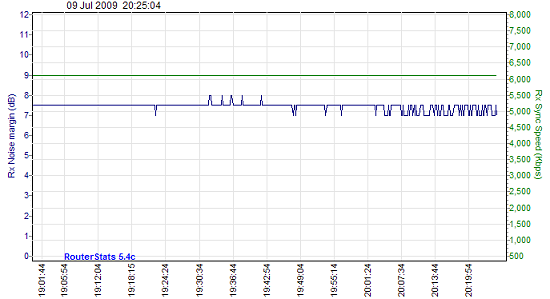

DG834 v2 - 3.01.38 (AR7)
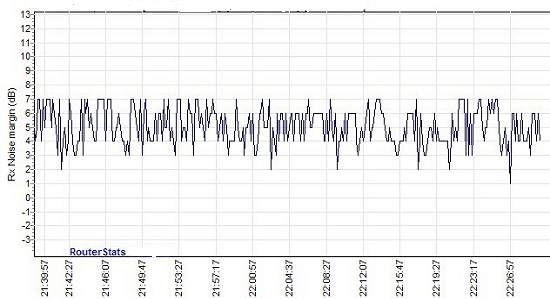

DG834G v3 - 4.01.37 (AR7)
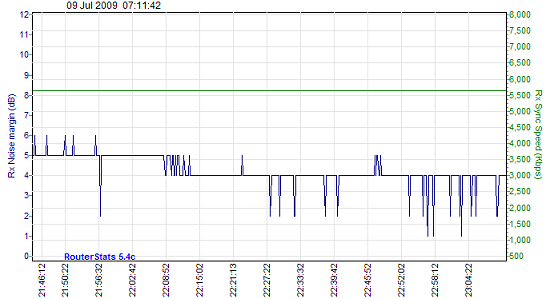

DG834G v4 - 5.01.09 (Broadcom)
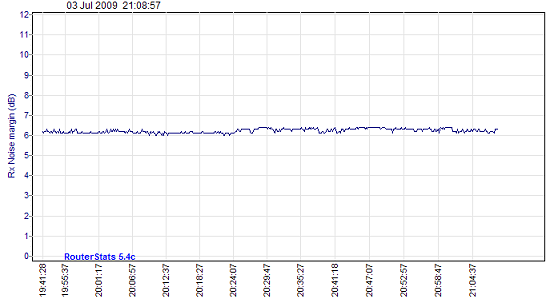

DG834G v5 - 6.00.25 (Conexant)
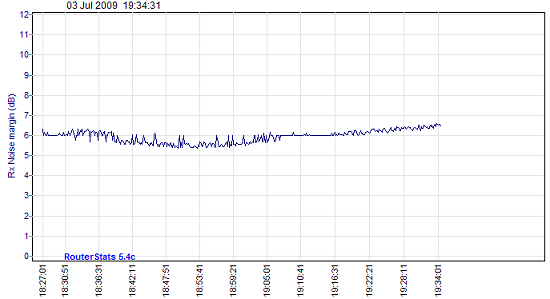
(The v5 does not provide any bitloading or snr/tone figures)
DG834GT - 1.02.16-DGTeam-0848 (Broadcom)
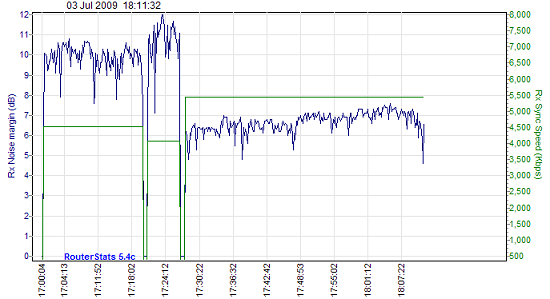 The apparent poor performance of the DG834GT was unexpected and seems to indicate
a fault with my particular router (see conclusion notes.)
The apparent poor performance of the DG834GT was unexpected and seems to indicate
a fault with my particular router (see conclusion notes.)
ZyXEL P-660HW-T1 v2 - f/w v3.40 (AR7 ??)
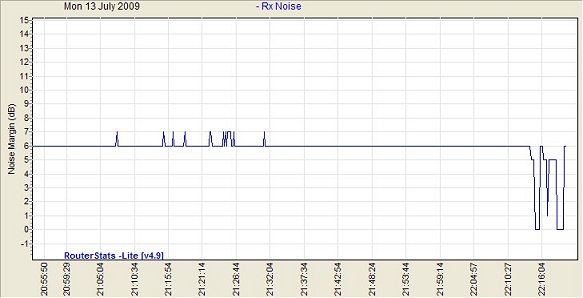
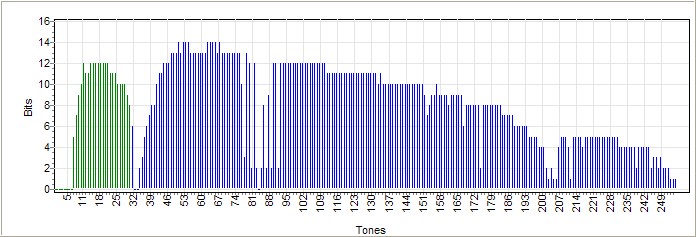
Conclusions
Everyone's line is different - these are my conclusions based on the routers I tested on my line at the time I tested them.The DG834 v2 and DG834G v3 were very similar. I only used the official Netgear firmware versions with these routers. Both showed a marked and continuous variation in noise margin - a graph which I'd come to expect with these routers whether on BT IPStream and now on Be* LLU. Both also showed a marked tendency to give a much lower noise margin after sunset and, although they held onto the connection well with a very low noise margin, the potential to drop the connection - especially at night - was ever present.
The DG834G v4 performed well. It provided a good connection speed with a noise margin which was consistently at the 'target' margin of 6 dB. The small variation in noise margin throughout the day didn't get any worse at night although the average value probably dropped by, maybe 1 dB. Overall, a very stable router that I hope keeps running for many years. I'm deliberately not running the latest firmware on this router [5.01.14] because it no longer provides 'NAT Loopback' - a software facility which is virtually indispensable to run my video servers. I didn't try the DGTeam firmware for this particular test although I have used it on IPStream and saw no performance benefit. (Edit: The very latest firmware [5.01.16] does now provide NAT Loopback. The graphs and figures shown here are with version 5.01.09).
The DG834G v5 surprized me in that it performed very well. The 'Conexant' chipset gave a steady noise margin which provided a graph very similar to the DG834G v4. Although it's connection speed was slightly down compared with the v4, I'd be happy to use this version - except, like the latest v4 firmware, it also doesn't provide NAT Loopback. The Conexant chipset - at least as implemented in the v5 - doesn't seem to provide the same in-depth statistics as the other routers which will also tend to discourage me from using it.
The DG834GT also surprized me but for the opposite reason. I had expected it to perform at least as well as the DG834G v4 but, as you can see from the graph, it was much too unstable to use for any length of time. Even after forcing it to adopt a 100% target Noise Margin (ie. effectively reset to 6 dB), it still drifted anywhere between 15 and 2 dB - even losing the connection and re-syncing at a different rate. I tried it with a spare power brick, in case the power supply was faulty, and had a quick look round inside for any obvious loose or badly-soldered connections. The official Netgear firmware and the DGTeam firmware both gave identical disappointing results. My conculsion is that the DG834GT doesn't suit my particular line or the router has developed an internal fault. If I have the opportunity to try a different one, I'll add to these notes.
The ZyXEL P-660HW-T1 performed quite well. Despite the big chunk out of the bitloading, it made up for it by having a flatter 'top' to the curve - meaning more bits/tone were squeezed into the mid-tones. The Noise Margin was quite stable, varying between 6dB and 7dB most of the time. However, it does seem to be quite susceptible to noise on the line and drops the connection too easily.